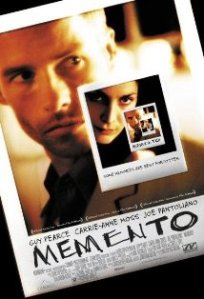"Memento" is a 2000 American psychological thriller film which portrays two separate stories of Leonard, an ex-insurance investigator who has anterograde amnesia so can no longer build new memories, as he attempts to find the murderer of his wife which is the last thing he remembers. The events of the film unfold in two separate alternating narratives, one in black and white which moves forward chronologically in time, whilst the other in colour tells the story in reverse order, revealing more each time. As each sequence begins, the audience is unaware of the preceding events, just like Leonard, thereby giving the viewer a sense of his confusion and being able to relate to him. The film starts with Leonard killing Teddy for the rape and murder of his wife, then as the film ends when the two narratives converge, we understand the events that lead up to Leonard killing Teddy.
“Memento”, is one of those films whereby the ending is shown at the beginning, so in the opening clip of the film we can Leonard shooting Teddy, which is shown in colour as it is the end of the film and going in reverse chronological order. The clip moves backwards as we see the image on the Polaroid photo vanish, it’s then put back into the camera and the bullet is reloaded into the gun before Leonard pulls the trigger. At 1:44 the edit cuts to black and white to show Leonard in a hotel room, to represent the forward chronological order of the story. The use of the non-diegetic music helps to create apprehension and suspense, hence engaging the audience and at 1:42 the music builds to a climax and increases in volume as Leonard is waiting to pull the trigger of the gun. We have discussed when we come to edit our film, we may decide to use different lighting to portray the two different lives that our main character could lead, hence making it more obvious and less confusing for our demograph.
"Memento” also includes a voiceover in some parts, which is something we are looking into when we create our short film. This is because, as it revolves around one character there is no need for dialogue, so we thought that a voiceover may be needed to assist the audience. However, we also think that just the footage and a suitable piece of non-diegetic music may be more effective.
Although our film is of a different genre, “Memento” can be classed similar to our short film, as they both have two alternative narratives, however in “Memento” they are going in opposite orders but telling the same story, whereas in our film, they are running parallel, yet portraying two different lives.
If we look at the poster for “Memento”, it has been cleverly constructed to portray Polaroid photos within other Polaroid photos, relating to a memory inside a memory. The Polaroid photos are one of the key features of the film, as Leonard has short term memory loss, so has to take pictures of everything to help him in his investigation to find out who killed his wife. Moreover, the use of font at the bottom of the Polaroid picture, stating the title of the film has been written in quite a handwriting style font, thus relating to the film, in which once he takes pictures he writes a description, which he normally has tattooed to himself so he doesn’t forget. Therefore, this poster reflects the film vastly and includes the tagline “Some memories are best forgotten”, which is ironic to the film, as the last memory he can remember is of his wife being killed, yet he forgets everything else.

No comments:
Post a Comment